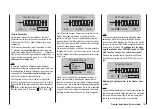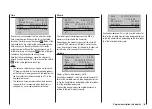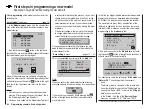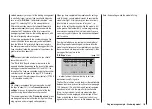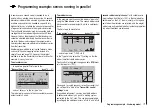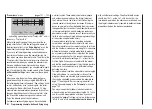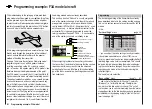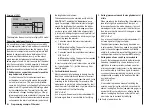
172
Programming example - fixed-wing model
Controlling the electric motor and butterfly (crow)
system using the Ch 1 stick
Example 4
Butterfly / crow system as landing aid: ailerons up,
flaps down
Before we start the programming of this fourth example,
and turn our attention to expanding the basic program-
ming we have already discussed, we need to consider
briefly the position of the throttle / brake stick at “motor
OFF” or “brake OFF”. Usually the Ch 1 stick is moved
forward to open the throttle, and back to extend the
brakes. However, if you adopt this “classic” configura-
tion, and switch, say, from “motor OFF” (stick “back”)
to the braking system, “full brake” would immediately
be applied, and vice versa: if you switch from “brakes
retracted” to power, this would instantly switch to “full
power”.
It is certainly possible to make a “virtue” out of this
“vice”: a “glider pilot” - usually flying with “brakes re-
tracted = forward” will only switch to motor “ON” when
necessary, and then reduce power to suit the situation
(and - we hope - does not forget to move the Ch 1 stick
back to the “forward” position when switching back). In
contrast, a typical “power pilot” would probably operate
with the reverse priority, i. e. he would only switch to
“brake” when necessary, etc. In any case, it is possible
to avoid these inter-connected effects by positioning the
“zero point” of both systems so that they coincide. The
above considerations mean that a “glider pilot” will prob-
ably prefer the “zero point forward” arrangement, while a
“power pilot” might well decide on “zero point back”.
The
mx-16
HoTT transmitter can cope with whichever
arrangement you prefer. However, the following section
assumes that both “OFF” positions will be set to “for-
ward”. If you prefer the alternative arrangement, there is
no problem: the only difference compared with the ver-
sion described here is that you would select “none/inv”
in the “Motor at Ch 1” line of the “
Base settings
” menu
instead of “none”. All the other settings can be adopted
as described.
In the …
“Transmitter control settings”
menu
mod name
stick mode
CH8 delay
motor at C1
1
yes
no
tail type
normal
GRAUBELE
… leave the “
motor at Ch 1”
line at “none” if you have
set “Motor ON = forward”, or switch to “none/inv” if
preferred. This is essential, otherwise the “
Brake 1
NN
*” mixers which we need will be suppressed in the
“
Fixed-wing mixers
” menu.
Important Note:
As it is essential to set the motor to “none”, this also
automatically disables the “Throttle too high” power-
on warning! For this reason please take great care
to set the Ch 1 stick to the correct position before
you switch the receiving system on.
The next step is to ensure that the speed controller con-
nected to receiver output 1 is switched off “at the right
end”. To accomplish this you may have to move to the …
* NN = Nomen Nominandum (name to be stated)
“Servo settings”
menu
S4
S5
S6
rev cent
+
trav
0%
0%
0%
100% 100%
100% 100%
100% 100%
0%
0%
100% 100%
100% 100%
S7
S8
The last stage is to check the settings, so move from
the basic display to “
Servo display
” by simultaneously
touching the
buttons of the left-hand touch-key: in
the (upper) “OFF” position of the three-position switch
the control channel you have selected - in our example
this is channel “8” - should be at -100%. If you now move
the switch toggle to the centre position, the bar should
be in the middle, and at the (lower) “full-throttle” setting it
should be at +100%.
Summary of Contents for mx-12 Hott
Page 1: ...Programming Manual 33116 mx 16 HoTT 3 en mx 16...
Page 35: ...35 For your notes...
Page 49: ...49 For your notes...
Page 55: ...55 For your notes...
Page 59: ...59 For your notes...
Page 63: ...63 For your notes...
Page 69: ...69 For your notes...
Page 91: ...91 For your notes...
Page 101: ...101 For your notes...
Page 123: ...123 For your notes...
Page 181: ...181 For your notes...
Page 193: ...193 For your notes...


